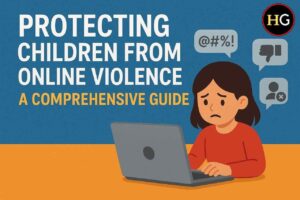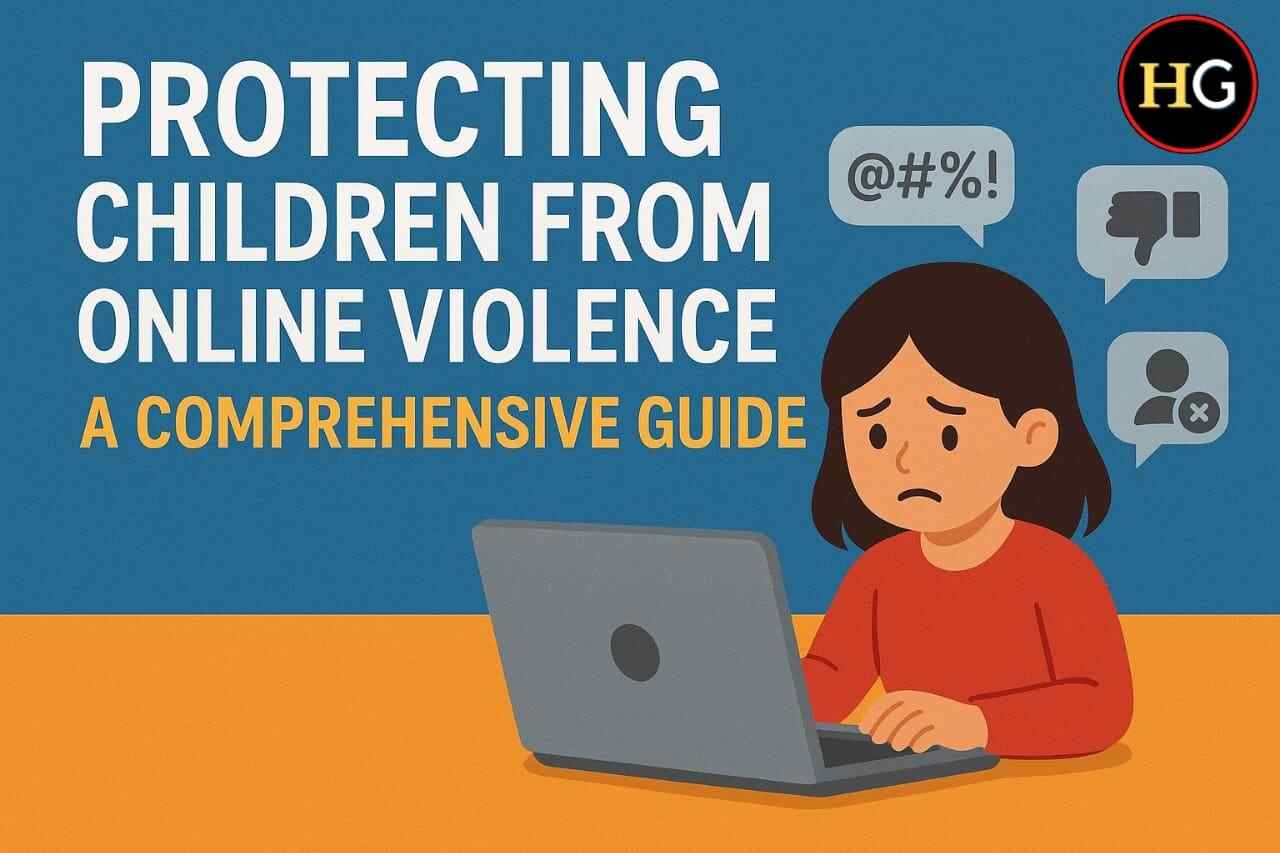Protecting Children from Online Violence: A Comprehensive Guide
Protecting Children from Online Violence: In today’s digital age, the internet has become an integral part of children’s lives. From online learning platforms to social media, gaming, and messaging apps, children spend a significant portion of their day online. While the internet provides many opportunities for education, creativity, and social interaction, it also exposes children to various forms of online violence. This can include cyberbullying, inappropriate content, online predators, and digital harassment. Protecting children from these threats is crucial for their mental, emotional, and physical well-being.
This article explores the nature of online violence, its effects on children, and practical strategies parents, educators, and caregivers can use to ensure a safe digital environment.
Understanding Online Violence
Online violence refers to harmful behaviors or content that children may encounter on the internet. Unlike traditional forms of violence, online violence is often invisible and can occur at any time or place, making it more challenging to detect and address. Common forms of online violence include:
1. Cyberbullying
Cyberbullying is the use of digital platforms to harass, threaten, or humiliate someone. It can take the form of abusive messages, spreading rumors, sharing embarrassing images or videos, or creating fake profiles. Studies have shown that cyberbullying can have severe effects on children’s mental health, including anxiety, depression, and even suicidal tendencies.
2. Exposure to Inappropriate Content
Children may unintentionally access content that is violent, sexual, or otherwise inappropriate for their age. Such exposure can affect their psychological development and normalize harmful behaviors.
3. Online Predators
Some adults exploit the anonymity of the internet to target children. Online predators may use chat rooms, social media, or gaming platforms to gain a child’s trust, manipulate them, or exploit them.
4. Identity Theft and Fraud
Children may unknowingly share personal information online, making them vulnerable to scams or identity theft. This can lead to financial harm and long-term privacy issues.
5. Digital Harassment
Harassment online can include repeated offensive messages, doxxing (sharing personal information publicly), or targeted attacks on social media. Unlike physical violence, digital harassment often leaves a lasting digital footprint that can impact a child’s reputation and mental health.
Impact of Online Violence on Children
Online violence can have severe and lasting consequences for children. Understanding these effects can help parents and caregivers take proactive steps to prevent harm.
1. Emotional and Psychological Effects
Children exposed to online violence may experience anxiety, depression, low self-esteem, or feelings of isolation. Repeated exposure to cyberbullying or harassment can trigger long-term mental health issues.
2. Academic Performance
Stress, fear, or distraction caused by online violence can affect a child’s focus and performance in school. In some cases, children may avoid attending school or participating in online learning to escape online threats.
3. Social Development
Children may struggle to develop healthy social skills if they face constant online harassment. They may become withdrawn, distrustful, or overly cautious in social interactions, both online and offline.
4. Physical Health
Prolonged stress and anxiety can manifest in physical symptoms, including headaches, stomachaches, sleep disturbances, and changes in appetite.
Strategies to Protect Children from Online Violence
Protecting children from online violence requires a combination of awareness, education, supervision, and technology. Here are practical strategies that can help:

1. Educate Children About Online Risks
Knowledge is the first line of defense. Parents and educators should teach children about potential online threats, including cyberbullying, inappropriate content, and online predators. Important tips include:
-
Avoid sharing personal information online.
-
Be cautious when interacting with strangers on the internet.
-
Recognize the signs of cyberbullying or manipulation.
-
Report any harmful content or suspicious behavior immediately.
2. Encourage Open Communication
Children should feel comfortable discussing their online experiences with trusted adults. Parents can:
-
Schedule regular conversations about online activities.
-
Listen without judgment or immediate criticism.
-
Encourage children to share screenshots or examples of concerning behavior.
3. Use Parental Controls and Monitoring Tools
Technology can assist in safeguarding children online. Parental controls can:
-
Limit access to age-inappropriate websites or apps.
-
Monitor screen time and online activity.
-
Filter harmful content and prevent accidental exposure.
Popular parental control tools include Qustodio, Net Nanny, Kaspersky Safe Kids, and Google Family Link.
4. Promote Digital Literacy
Teaching children to think critically about online content is essential. Digital literacy skills include:
-
Evaluating the credibility of websites and social media accounts.
-
Recognizing fake news, scams, and manipulative tactics.
-
Understanding the consequences of sharing personal information online.
5. Set Clear Rules and Boundaries
Establishing clear guidelines for internet use helps children navigate the online world safely. Rules may include:
-
Limiting screen time, especially at night.
-
Avoiding online interactions with strangers.
-
Restricting access to certain apps, websites, or social media platforms.
-
Using privacy settings to protect personal information.
6. Foster Positive Online Behavior
Encouraging children to be responsible digital citizens can reduce the risk of online violence. Teach children to:
-
Treat others with respect online.
-
Avoid sharing hurtful or harmful content.
-
Report abusive behavior instead of retaliating.
7. Be Aware of Red Flags
Parents and caregivers should watch for signs that a child may be experiencing online violence, such as:
-
Sudden changes in mood or behavior.
-
Avoiding social situations or withdrawing from friends.
-
Reluctance to use electronic devices.
-
Decline in academic performance.
8. Collaborate with Schools and Communities
Schools play a critical role in preventing online violence. Parents should:
-
Participate in school awareness programs about cyber safety.
-
Encourage schools to provide workshops on online safety and digital literacy.
-
Advocate for policies that address cyberbullying and online harassment.
Legal Protections Against Online Violence
Many countries have enacted laws to protect children from online violence. Understanding these laws can empower parents and caregivers to take action when needed:
-
Cybercrime Laws: Address online harassment, identity theft, and illegal content.
-
Child Protection Laws: Criminalize exploitation and abuse of minors online.
-
Reporting Mechanisms: Platforms like Facebook, Instagram, and YouTube provide reporting tools for inappropriate content or harassment.
Parents should familiarize themselves with local regulations and report serious incidents to law enforcement when necessary.
Building a Supportive Environment
Creating a safe online environment requires more than just rules and technology. Emotional support, trust, and guidance are equally important:
-
Encourage children to share their online experiences.
-
Praise positive online behavior and responsible decision-making.
-
Provide alternatives to screen time, such as outdoor activities or creative hobbies.
-
Teach coping strategies for dealing with negative experiences online.
Case Studies and Real-Life Examples
Example 1: Cyberbullying Prevention
A 13-year-old girl was constantly harassed on social media by classmates. Her parents noticed changes in her behavior and immediately intervened by:
-
Reporting the accounts to the platform.
-
Blocking the bullies.
-
Seeking counseling support.
As a result, the harassment stopped, and the child regained confidence.
Example 2: Avoiding Online Predators
A 12-year-old boy was approached by a stranger in an online gaming chat. Thanks to prior education on internet safety, he:
-
Refused to share personal information.
-
Reported the user to the game’s moderators.
-
Informed his parents about the incident.
The boy avoided potential exploitation, highlighting the importance of awareness and communication.
ALSO READ: What is Reddit and How Does It Work? – A Complete Guide
Conclusion
Online violence is a serious threat to children’s safety, mental health, and development. In a world where digital interactions are increasingly prevalent, protecting children requires a proactive and multifaceted approach. Education, communication, technological tools, and supportive environments are all essential components of a comprehensive safety strategy.
By fostering awareness, promoting responsible online behavior, and creating safe digital spaces, parents, educators, and communities can ensure that children enjoy the benefits of the internet without falling prey to its dangers. Every step taken to protect children from online violence contributes to their overall well-being and helps nurture a generation of digitally responsible and resilient individuals.
